2011 Peugeot 508 wheel
[x] Cancel search: wheelPage 164 of 340
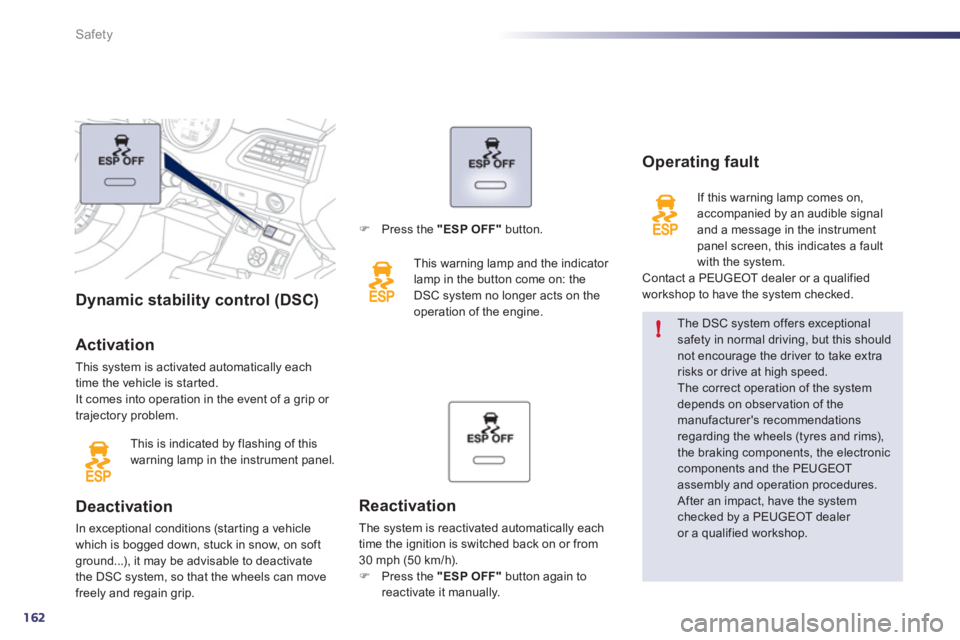
162
!
Safety
Dynamic stability control (DSC)
Activation
This system is activated automatically each
time the vehicle is star ted.
It comes into operation in the event of a grip or
trajectory problem.
This is indicated by flashing of this
warning lamp in the instrument panel.
Deactivation
In exceptional conditions (starting a vehicle
which is bogged down, stuck in snow, on soft
ground...), it may be advisable to deactivate
the DSC system, so that the wheels can move
freely and regain grip. The DSC system offers exceptional
safety in normal driving, but this should
not encourage the driver to take extra
risks or drive at high speed.
The correct operation of the system
depends on obser vation of the
manufacturer's recommendations
regarding the wheels (tyres and rims),
the braking components, the electronic
components and the PEUGEOT
assembly and operation procedures.
After an impact, have the system
checked by a PEUGEOT dealer
or a qualified workshop.
Operating fault
If this warning lamp comes on,
accompanied by an audible signal
and a message in the instrument
panel screen, this indicates a fault
with the system.
Contact a PEUGEOT dealer or a qualified
workshop to have the system checked.
Reactivation
The system is reactivated automatically each
time the ignition is switched back on or from
30 mph (50 km/h).
�)
Press the "ESP OFF"
button again to
reactivate it manually.
�)
Press the "ESP OFF"
button.
This warning lamp and the indicator
lamp in the button come on: the
DSC system no longer acts on the
operation of the engine.
Page 168 of 340

166
i
!
Safety
Airbags
System designed to maximise the safety of the
occupants (with the exception of the rear centre
passenger) in the event of violent collisions.
It supplements the action of the force-limiting
seat belts (with the exception of the rear centre
passenger).
If a collision occurs, the electronic detectors
record and analyse the front and side impacts
sustained in the impact detection zones:
- in the case of a serious impact, the airbags
are deployed instantly and protect the
occupants of the vehicle (with the exception
of the rear centre passenger); immediately
after the impact, the airbags deflate rapidly
so that they do not hinder visibility or the
exit of the occupants,
- in the case of a minor or rear impact or in
cer tain roll-over conditions, the airbags
will not be deployed; the seat belt alone is
sufficient to provide optimum protection in
these situations.
The airbags do not operate when the
ignition is switched off.
This equipment will only deploy once.
If a second impact occurs (during
the same or a subsequent accident),
the airbag will not be deployed again. Deployment of the airbag(s) is
accompanied by a slight emission of
harmless smoke and a noise, due to the
activation of the pyrotechnic car tridge
incorporated in the system.
This smoke is not harmful, but sensitive
individuals may experience slight
irritation.
The noise of the detonation may result
in a slight loss of hearing for a short
time.
Impact detection zones
A.
Front impact zone.
B.
Side impact zone.
Front airbags
Deployment
The airbags are deployed simultaneously, unless
the passenger's front airbag is deactivated, in the
event of a serious front impact to all or par t of the
front impact zone A
, in the longitudinal centreline
of the vehicle on a horizontal plane and directed
from the front to the rear of the vehicle.
The front airbag inflates between the thorax
and head of the front occupant of the vehicle
and the steering wheel, driver's side, and the
dashboard, passenger's side to cushion their
for ward movement. System which protects the driver and front
passenger in the event of a serious front impact
in order to limit the risk of injury to the head and
thorax.
The driver's airbag is fitted in the centre of the
steering wheel; the front passenger's airbag is
fitted in the dashboard above the glove box.
Page 171 of 340
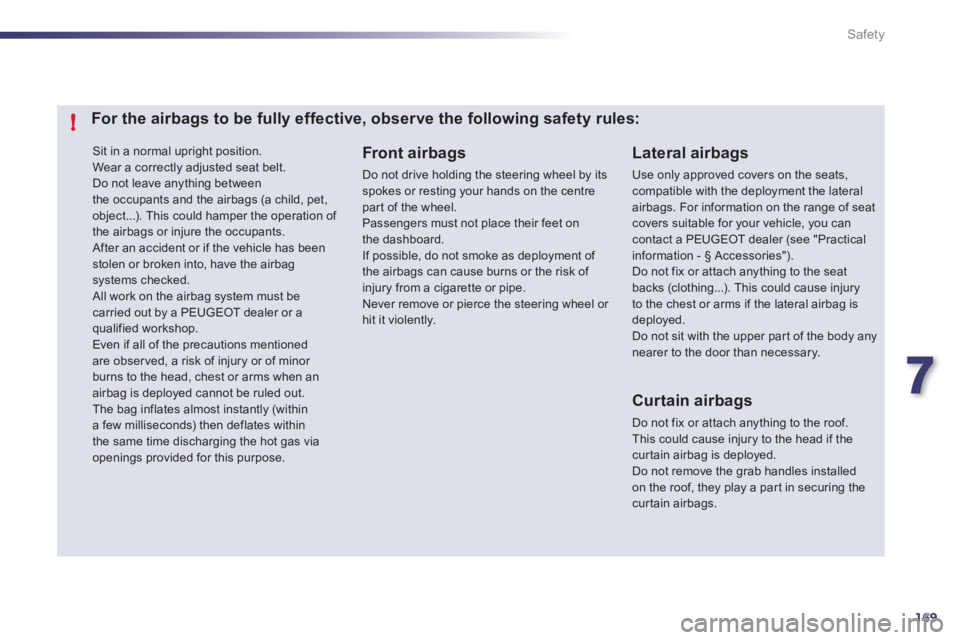
7
169
!
Safety
Sit in a normal upright position.
Wear a correctly adjusted seat belt.
Do not leave anything between
the occupants and the airbags (a child, pet,
object...). This could hamper the operation of
the airbags or injure the occupants.
After an accident or if the vehicle has been
stolen or broken into, have the airbag
systems checked.
All work on the airbag system must be
carried out by a PEUGEOT dealer or a
qualified workshop.
Even if all of the precautions mentioned
are obser ved, a risk of injury or of minor
burns to the head, chest or arms when an
airbag is deployed cannot be ruled out.
The bag inflates almost instantly (within
a few milliseconds) then deflates within
the same time discharging the hot gas via
openings provided for this purpose.
Lateral airbags
Use only approved covers on the seats,
compatible with the deployment the lateral
airbags. For information on the range of seat
covers suitable for your vehicle, you can
contact a PEUGEOT dealer (see "Practical
information - § Accessories").
Do not fix or attach anything to the seat
backs (clothing...). This could cause injury
to the chest or arms if the lateral airbag is
deployed.
Do not sit with the upper par t of the body any
nearer to the door than necessary.
Front airbags
Do not drive holding the steering wheel by its
spokes or resting your hands on the centre
part of the wheel.
Passengers must not place their feet on
the dashboard.
If possible, do not smoke as deployment of
the airbags can cause burns or the risk of
injury from a cigarette or pipe.
Never remove or pierce the steering wheel or
hit it violently.
Curtain airbags
Do not fix or attach anything to the roof.
This could cause injury to the head if the
cur tain airbag is deployed.
Do not remove the grab handles installed
on the roof, they play a par t in securing the
curtain airbags.
For the airbags to be fully effective, observe the following safety rules:
Page 172 of 340
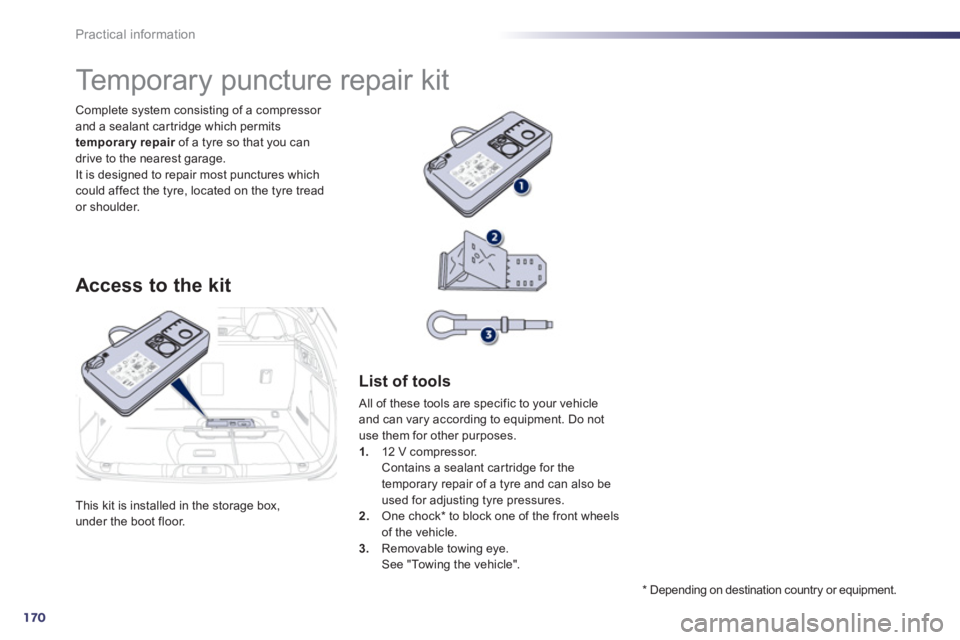
170
Practical information
This kit is installed in the storage box,
under the boot floor. Complete system consisting of a compressor
and a sealant car tridge which permits
temporary repair
of a tyre so that you can
drive to the nearest garage.
It is designed to repair most punctures which
could affect the tyre, located on the tyre tread
or shoulder.
Temporary puncture repair kit
Access to the kit
List of tools
All of these tools are specific to your vehicle
and can vary according to equipment. Do not
use them for other purposes.
1.
12 V compressor.
Contains a sealant cartridge for the
temporary repair of a tyre and can also be
used for adjusting tyre pressures.
2.
One chock * to block one of the front wheels
of the vehicle.
3.
Removable towing eye.
See "Towing the vehicle".
* Depending on destination country or equipment.
Page 173 of 340
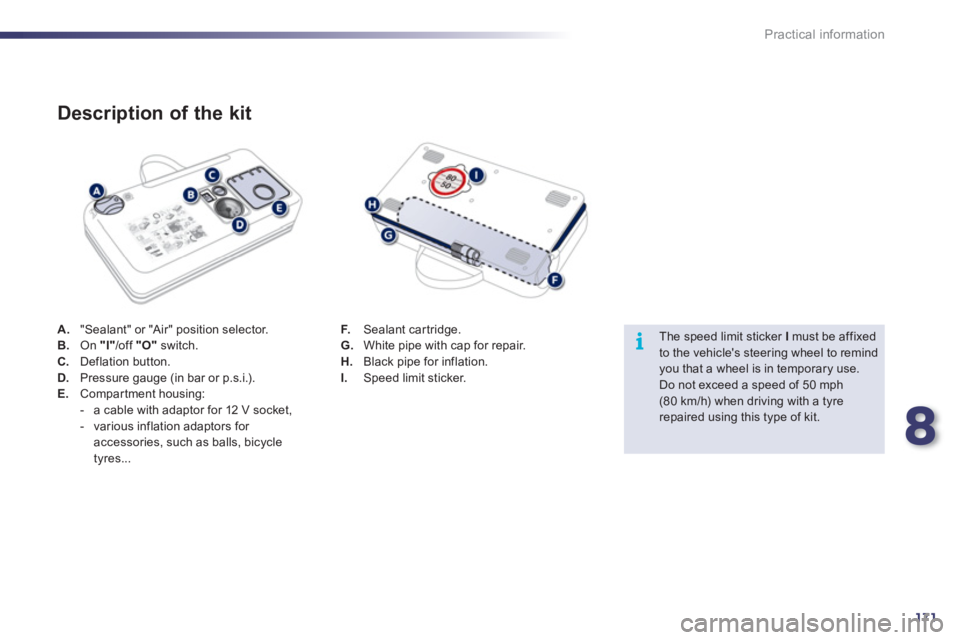
8
171
i
Practical information
A.
"Sealant" or "Air" position selector.
B.
On "I"
/of f "O"
switch.
C.
Deflation button.
D.
Pressure gauge (in bar or p.s.i.).
E.
Compar tment housing:
- a cable with adaptor for 12 V socket,
- various inflation adaptors for
accessories, such as balls, bicycle
tyres...
Description of the kit
F.
Sealant car tridge.
G.
White pipe with cap for repair.
H.
Black pipe for inflation.
I.
Speed limit sticker.
The speed limit sticker I
must be affixed
to the vehicle's steering wheel to remind
you that a wheel is in temporary use.
Do not exceed a speed of 50 mph
(80 km/h) when driving with a tyre
repaired using this type of kit.
Page 175 of 340
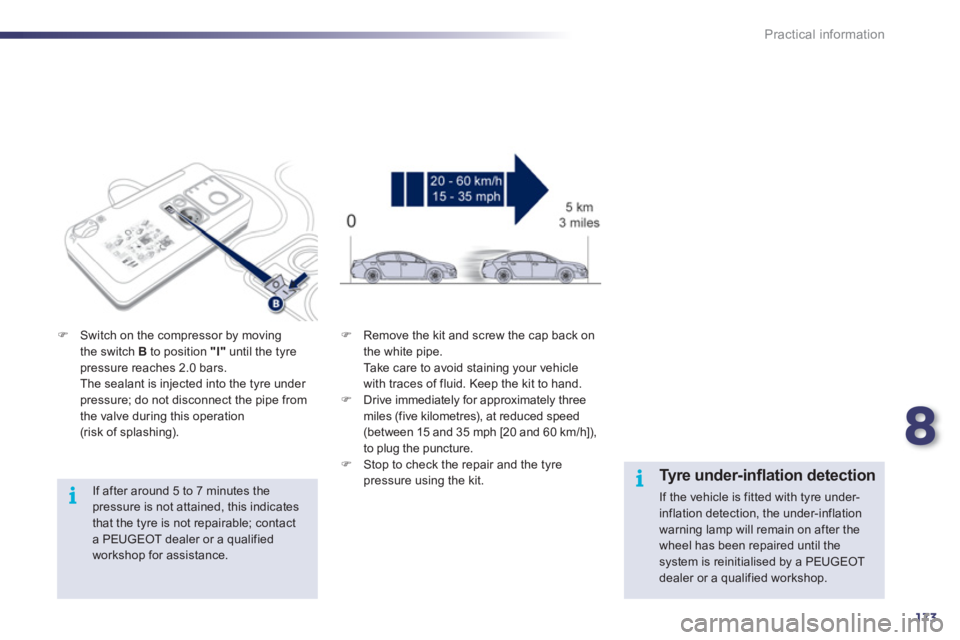
8
173
i
i
Practical information
If after around 5 to 7 minutes the
pressure is not attained, this indicates
that the tyre is not repairable; contact
a PEUGEOT dealer or a qualified
workshop for assistance.
�)
Switch on the compressor by moving
the switch B
to position "I"
until the tyre
pressure reaches 2.0 bars.
The sealant is injected into the tyre under
pressure; do not disconnect the pipe from
the valve during this operation
(risk of splashing).
�)
Remove the kit and screw the cap back on
the white pipe.
Take care to avoid staining your vehicle
with traces of fluid. Keep the kit to hand.
�)
Drive immediately for approximately three
miles (five kilometres), at reduced speed
(between 15 and 35 mph [20 and 60 km/h]),
to plug the puncture.
�)
Stop to check the repair and the tyre
pressure using the kit.
Ty r e u n d e r - i nfl ation detection
If the vehicle is fitted with tyre under-
inflation detection, the under-inflation
warning lamp will remain on after the
wheel has been repaired until the
system is reinitialised by a PEUGEOT
dealer or a qualified workshop.
Page 176 of 340
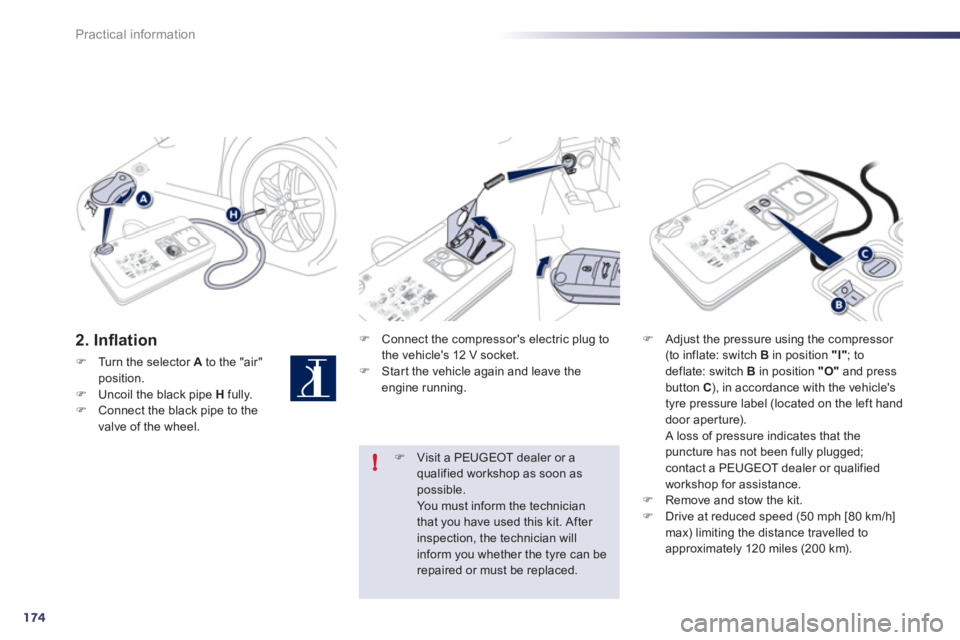
174
!
Practical information
2. Infl ation
�)
Turn the selector A
to the "air"
position.
�)
Uncoil the black pipe H
fully.
�)
Connect the black pipe to the
valve of the wheel.
�)
Connect the compressor's electric plug to
the vehicle's 12 V socket.
�)
Star t the vehicle again and leave the
engine running.
�)
Adjust the pressure using the compressor
(to inflate: switch B
in position "I"
; to
deflate: switch B
in position "O"
and press
button C
), in accordance with the vehicle's
tyre pressure label (located on the left hand
door aperture).
A loss of pressure indicates that the
puncture has not been fully plugged;
contact a PEUGEOT dealer or qualified
workshop for assistance.
�)
Remove and stow the kit.
�)
Drive at reduced speed (50 mph [80 km/h]
max) limiting the distance travelled to
approximately 120 miles (200 km).
�)
Visit a PEUGEOT dealer or a
qualified workshop as soon as
possible.
You must inform the technician
that you have used this kit. After
inspection, the technician will
inform you whether the tyre can be
repaired or must be replaced.
Page 177 of 340
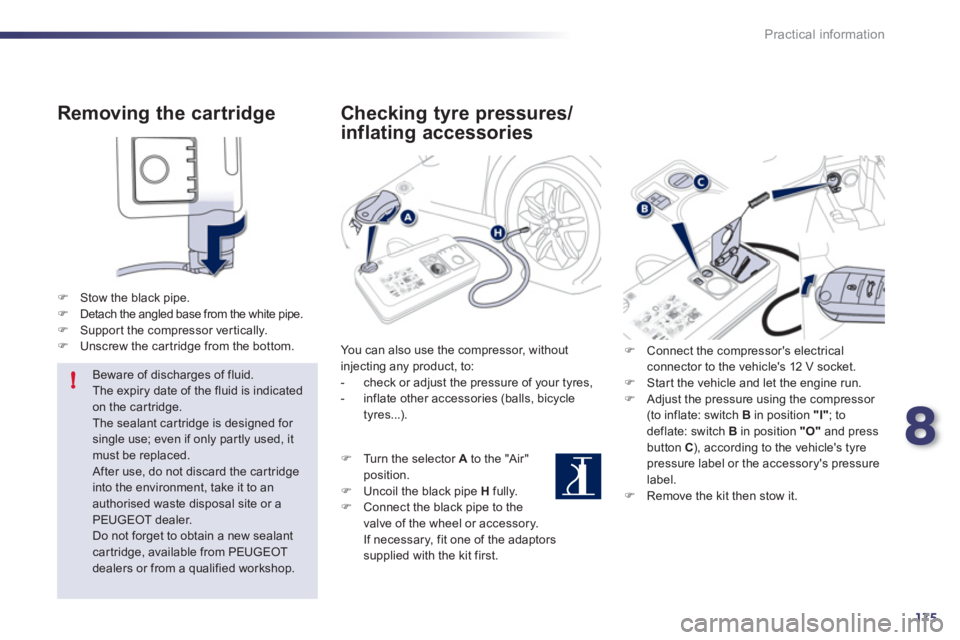
8
175
!
Practical information
Removing the cartridge
�)
Stow the black pipe.
�)
Detach the angled base from the white pipe.
�)
Suppor t the compressor ver tically.
�)
Unscrew the car tridge from the bottom.
Beware of discharges of fluid.
The expiry date of the fluid is indicated
on the car tridge.
The sealant car tridge is designed for
single use; even if only par tly used, it
must be replaced.
After use, do not discard the car tridge
into the environment, take it to an
authorised waste disposal site or a
PEUGEOT dealer.
Do not forget to obtain a new sealant
car tridge, available from PEUGEOT
dealers or from a qualified workshop.
Checking tyre pressures/
inflating accessories
You can also use the compressor, without
injecting any product, to:
- check or adjust the pressure of your tyres,
- inflate other accessories (balls, bicycle
tyres...).
�)
Turn the selector A
to the "Air"
position.
�)
Uncoil the black pipe H
fully.
�)
Connect the black pipe to the
valve of the wheel or accessory.
If necessary, fit one of the adaptors
supplied with the kit first.
�)
Connect the compressor's electrical
connector to the vehicle's 12 V socket.
�)
Star t the vehicle and let the engine run.
�)
Adjust the pressure using the compressor
(to inflate: switch B
in position "I"
; to
deflate: switch B
in position "O"
and press
button C
), according to the vehicle's tyre
pressure label or the accessory's pressure
label.
�)
Remove the kit then stow it.